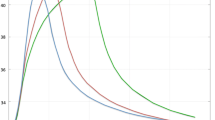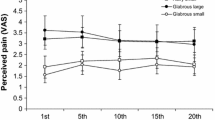Abstract
We compared the effect of skin temperature on the critical threshold temperature eliciting heat pain with the effect of skin temperature on the response latency to the first heat pain sensation in healthy human subjects. Also, we determined the effect of the duration of a heat stimulus ramp on pain threshold. Furthermore, we determined the effect of skin temperature on mechanically induced pain. We found that the latency to the first pain sensation induced by a radiant heat stimulus was significantly decreased with an increase in the skin temperature (25–35 °C). However, independent of the rate of the stimulus rise (3–10 °C/s) and independent of the stimulus location (hairy vs glabrous skin), the threshold temperature for eliciting the heat pain sensation, determined with a contact thermostimulator, was not changed by a change in the skin temperature in the same subjects. With a fast rate of stimulus rise, a higher pain threshold was obtained than with a slow rise of stimulus temperature. However, this difference was found only with subject-controlled ascending stimuli (method of limits) but not with experimenter-controlled, predetermined stimulus ramps (method of levels). The heat pain threshold was higher in the glabrous skin of the hand than in the hairy skin of the forearm. With increasing stimulus duration (2.5–10s), the threshold temperature eliciting the heat pain sensation was significantly decreased. The mechanically induced pain threshold was not influenced by the skin temperature. The results indicate that the critical temperature for eliciting heat pain is independent of the skin temperature in humans. However, a change in skin temperature is an important source of an artefactual change in heat pain sensitivity when the radiant heat method (latency or energy) is used as an index of pain sensitivity. With a method dependent on reaction time (the method of limits), the heat pain threshold was artefactually increased, with fast rates of stimulus rise due to the long delay of slowly conducting heat pain signals in reaching the brain. With an increase in the duration of the heat stimulus, the critical temperature for eliciting pain sensation was significantly decreased, which may be explained by central neuronal mechanisms (temporal summation).
Similar content being viewed by others
References
Adriaensen HJ, Gybels J, Handwerker HO, VanHees J (1983) Response properties of thin myelinated (A-δ) fibres in human skin nerves. J Neurophysiol 49: 111–122
Adriaensen HJ, Gybels J, Handwerker HO, VanHees J (1984) Suppression of C-fibre discharges upon repeated heat stimulation may explain characteristics of concomitant pain sensations. Brain Res 302: 203–211
Arendt-Nielsen L, Bjerring P (1988) Sensory and pain threshold characteristics to laser stimuli. J Neurol Neurosurg Psychiatry 51: 35–42
Benjamin FB (1959) Spatial summation of pain. Proc Soc Exp Biol Med 101: 380–382
Berge OG, Garcia-Cabrera I, Hole K (1988) Response latencies in the tail-flick test depend on tail skin temperature. Neurosci Lett 86: 284–288
Birren JE, Casperson RC, Botwinick J (1951) Pain measurement by the radiant heat method: individual differences in pain sensitivity, the effects of skin temperature, and stimulus duration. J Exp Psychol 41: 419–424
Bromm B, Jahnke MT, Treede RD (1984) Responses of human cutaneous afferents to CO2 laser stimuli causing pain. Exp Brain Res 55: 158–166
Campbell JN, LaMotte RH (1983) Latency to detection of first pain. Brain Res 266: 203–208
Casey KL, Butler J, Lewis KG, Morrow TJ (1987) Evidence that the distribution of polymodal nociceptors does not determine both thermal and mechanical pain thresholds of human glabrous and hairy skin. Soc Neurosci Abstr 13: 189
Croze S, Duclaux R (1978) Thermal pain in humans: influence of the rate of stimulation. Brain Res 157: 418–421
Croze S, Duclaux R, Kenshalo DR (1976) The thermal sensitivity of the polymodal nociceptors in the monkey. J Physiol (Lond) 263: 539–562
Croze S, Duclaux R, Russek M (1977) Constancy of heat pain characteristics to changes in skin and body temperature. Brain Res 131: 367–372
Douglass DK, Carstens E, Watkins LR (1992) Spatial summation in human thermal pain perception: comparison with and between dermatomes. Pain 50: 197–202
Duggan AW, Griersmith BT, Headley PM, Maher JB (1978) The need to control skin temperature when using radiant heat in tests of analgesia. Exp Neurol 61: 471–478
Greene LC, Hardy JD (1958) Spatial summation of pain. J Appl Physiol 13: 457–164
Hall KR (1955) Relation of skin temperature to pain threshold. Q J Exp Psychol 7: 74–81
Hallin RG, Torebjörk HE, Wiesenfeld Z (1981) Nociceptors and warm receptors innervated by C fibres in human skin. J Neurol Neurosurg Psychiatry 45: 313–319
Hardy JD, Goodell H, Wolff HG (1951) The influence of skin temperature upon the pain threshold as evoked by thermal radiation. Science 114: 149–150
Hardy JD, Wolff HG, Goodell H (1952) Pain sensations and reactions. Williams & Wilkins, Baltimore
Hole K, Tjolsen A (1993) The tail-flick and formalin tests in rodents: changes in skin temperature as a confounding factor. Pain 53: 247–254
Kojo I, Pertovaara A (1986) Effect of tourniquet-induced ischemia on cutaneous thermal thresholds. Acta Neurol Scand 74: 383–386
Kojo I, Pertovaara A (1987) The effects of stimulus area and adaptation temperature on warm and heat pain thresholds in man. Int J Neurosci 32: 875–880
Lichtman AH, Smith FL, Martin BR (1993) Evidence that the antinociceptive tail-flick response is produced independently from changes in either tail-skin temperature or core temperature. Pain 55: 283–295
Luukko M, Konttinen Y, Kemppinen P, Pertovaara A (1994) Influence of various experimental parameters on the incidence of thermal and mechanical hyperalgesia induced by a constriction mononeuropathy of the sciatic nerve in lightly anesthetized rat. Exp Neurol 128: 143–154
Lynn B (1979) The heat sensitization of polymodal nociceptors in the rabbit and its independence of the local blood flow. J Physiol (Lond) 287: 493–507
Machet-Pietropaoli H, Chery-Croze S (1979) Spatial summation of thermal pain in human beings. Sensory Process 3: 183–187
Mendell LM (1966) Physiological properties of unmyelinated fibre projections to the spinal cord. Exp Neurol 16: 316–332
Milne RJ, Gamble GD (1989) Habituation to sham testing procedures modifies tail-flick latencies: effects on nociception rather than vasomotor tone. Pain 39: 103–107
Pertovaara A, Kojo I (1985) Influence of the rate of temperature change on thermal thresholds in man. Exp Neurol 87: 439–445
Pertovaara A, Reinikainen K, Hari R (1984) The activation of unmyelinated or myelinated afferent fibers by brief infrared laser pulses varies with skin type. Brain Res 307: 341–343
Pertovaara A, Morrow TJ, Casey KL (1988) Cutaneous pain and detection thresholds to short CO2 laser pulses in humans: evidence on afferent mechanisms and the influence of varying stimulus conditions. Pain 34: 261–269
Price DD, Hu JW, Dubner R, Gracely RH (1977) Peripheral suppression of first pain and central summation of second pain evoked by noxious heat pulses. Pain 3: 57–68
Price DD, McHaffie JG, Larson MA (1989) Spatial summation of heat-induced pain: influence of stimulus area and spatial separation of stimuli on perceived sensation intensity and unpleasentness. J Neurophysiol 62: 1270–1279
Torebjörk HE, LaMotte RH, Robinson CJ (1984) Peripheral neural correlates of magnitude of cutaneous pain and hyperalgesia: imultaneous recordings in humans of sensory judgments of pain and evoked responses in nociceptors with C-fibres. J Neurophysiol 51: 325–339
Treede RD, Oakland DB, Meyer RA, Campbell JN (1990) The apparent heat threshold of C-fiber nociceptors is dependent on stimulus parameters. Soc Neurosci Abstr 16 416
VanHees J, Gybels J (1981) C nociceptor activity in human nerve during painful and non-painful skin stimulation. J Neurol Neurosurg Psychiatry 44: 600–607
Wilcox GL, Giesler GL (1984) An instrument using a multiple layer Peltier device to change skin temperature rapidly. Brain Res Bull 12: 143–146
Yarnitsky D, Ochoa JL (1990) Studies of heat pain sensation in man: perception thresholds, rate of stimulus rise and reaction time. Pain 40: 85–91
Yarnitsky D, Ochoa JL (1991) Differential effect of compressionischaemia block on warm sensation and heat-induced pain. Brain 114: 907–913
Yarnitsky D, Simone DA, Dotson RM, Cline MA, Ochoa JL (1992) Single C nociceptor responses and psychophysical parameters of evoked pain: effect of rate of rise of heat stimuli in humans. J Physiol (Lond) 450: 581–592
Author information
Authors and Affiliations
Rights and permissions
About this article
Cite this article
Pertovaara, A., Kauppila, T. & Hämäläinen, M.M. Influence of skin temperature on heat pain threshold in humans. Exp Brain Res 107, 497–503 (1996). https://doi.org/10.1007/BF00230429
Received:
Accepted:
Issue Date:
DOI: https://doi.org/10.1007/BF00230429




